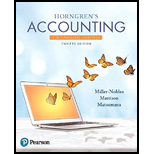
Direct Write-off Method: Under this method, actual losses from uncollectible accounts are charged to Bad-Debt expense. This method contravenes the matching rule because
Allowance Method: This Method creates an allowance for doubtful debts at the end of each period by means of an
1. Percentage of Sales Method.
2. Aging of Receivables method.
Allowance method complies with the matching rule as expense relating to a particular period is charged against revenues of that particular period. Also, under this method, receivables are recorded at their Net Realizable Value at the end of each period. Therefore, this method should be used for Financial Reporting purposes when the Bad Debt losses are material.
To Indicate:
The
Want to see the full answer?
Check out a sample textbook solution
Chapter 9 Solutions
Horngren's Accounting, The Financial Chapters (12th Edition)
- Zanzibar Limited entered into a lease agreement on July 1 2016 to lease some highly customized hydraulic equipment to Kaizen Limited. The fair value of the equipment as at that date was $700,000. The terms of the lease agreement were: Lease term Equipment economic life Annual rental payment, in arrears (commencing June 30th 2017) Equipment residual value Guaranteed residual value by Zanzibar Incremental borrowing rate 5 years 6 years $160,000 $100,000 $60,000 8% Interest rate implicit in the lease 6% Note: the lease is cancellable but only with Zanzibar's permission At the end of the lease term, the equipment is to be returned to Zanzibar Limited. On July 1, 2016, Zanzibar incurred $12,000 in legal fees for setting up the lease. The annual rental payment includes $10,000 to reimburse the lessor for maintenance fees incurred on behalf of the lessee. Requirements: a) Discuss the nature of the lease using the appropriate criteria. Justify your answer using calculations where applicable b)…arrow_forwardRepsola is a drilling company that operates an offshore Oilfield in Feeland. Five years ago, Feeland had a major oil discovery and granted licenses to drill oil to reputable, experienced drilling companies. The licensing agreement requires the company to remove the oil rig at the end of production and restore the seabed. Ninety percent of the eventual costs of undertaking the work relate to the removal of the oil rig and restoration of damage caused by building it and ten percent arise through the extraction of the oil. At the Statement of Financial Position (SOFP) date (December 31 2025), the rig has been constructed but no oil has been extracted On January 1st 2023, Repsola obtained the license to construct an oil rig at a cost of $500 million. Two years later the oil rig was completed. The rig is expected to be removed in 20 years from the date of acquisition. The estimated eventual cost is 100 million. The company's cost of capital is 10% and its year end is December 31st. Repsola…arrow_forward(a) A property lease includes a requirement that the premises are to be repainted every five years and the future cost is estimated at $100,000. The lessee prefers to spread the cost over the five years by charging $$20,000 against profits each year. Thereby creating a provision of $100,000 in five years' time and affecting profits equally each year. Requirement: Was it correct for the lessee to provide for this cost? Explain your decision (b) A retail store has a policy of refunding purchases by dissatisfied customers, even though it is under no legal obligation. Its policy of making refunds is generally known. Requirements: Should a provision be made at year endarrow_forward
- What is the correct answer of this question general Accounting?arrow_forwardFinancial accountingarrow_forwardPART B The Palmer School of Business operates a transportation service, solely for the purpose of providing commuting services to off-campus students. You have been hired as accounting students to analyze the cost of providing the transportation services and to develop a cost function which describes the behaviour of the related costs. The schools' administration has assembled the data for a twelve-month period pertaining to the monthly total costs of providing the service and the corresponding number of students who used the transportation system each month. You were recently taught how to use the Excel graphing tool, and a member of the team successfully generated the scattergram given below from the data set provided. Total Transportation Costs PALMER SCHOOL OF BUSINESS SCATTER DIAGRAM 300,000 Line of Best Fit 250,000 200,000 150,000 100,000 50,000 0 500 1,000 1,500 # of Students 2,000 2,500 3,000 The other team members are now tasked to use the graph to provide the administrators…arrow_forward

 AccountingAccountingISBN:9781337272094Author:WARREN, Carl S., Reeve, James M., Duchac, Jonathan E.Publisher:Cengage Learning,
AccountingAccountingISBN:9781337272094Author:WARREN, Carl S., Reeve, James M., Duchac, Jonathan E.Publisher:Cengage Learning, Accounting Information SystemsAccountingISBN:9781337619202Author:Hall, James A.Publisher:Cengage Learning,
Accounting Information SystemsAccountingISBN:9781337619202Author:Hall, James A.Publisher:Cengage Learning, Horngren's Cost Accounting: A Managerial Emphasis...AccountingISBN:9780134475585Author:Srikant M. Datar, Madhav V. RajanPublisher:PEARSON
Horngren's Cost Accounting: A Managerial Emphasis...AccountingISBN:9780134475585Author:Srikant M. Datar, Madhav V. RajanPublisher:PEARSON Intermediate AccountingAccountingISBN:9781259722660Author:J. David Spiceland, Mark W. Nelson, Wayne M ThomasPublisher:McGraw-Hill Education
Intermediate AccountingAccountingISBN:9781259722660Author:J. David Spiceland, Mark W. Nelson, Wayne M ThomasPublisher:McGraw-Hill Education Financial and Managerial AccountingAccountingISBN:9781259726705Author:John J Wild, Ken W. Shaw, Barbara Chiappetta Fundamental Accounting PrinciplesPublisher:McGraw-Hill Education
Financial and Managerial AccountingAccountingISBN:9781259726705Author:John J Wild, Ken W. Shaw, Barbara Chiappetta Fundamental Accounting PrinciplesPublisher:McGraw-Hill Education





